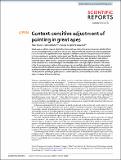Context-sensitive adjustment of pointing in great apes
Abstract
Great apes are able to request objects from humans by pointing. It is unclear, however, whether this is an associated response to a certain set of cues (e.g. the presence and attention of a human addressee) or a communicative signal which can be adjusted to relevant aspects of the spatial and social context. In three experiments, we tested captive great apes’ flexible use of pointing gestures. We manipulated the communicative context so that the default pointing response of apes would have indicated an undesired object, either due to 1) the spatial arrangements of the target objects, 2) the perspective of the addressee or 3) the knowledge of the addressee about the target objects’ location. The results of the three experiments indicate that great apes can successfully adjust their pointing to the spatial configuration of the referent environment such as distance and location of food. However, we found no evidence that they take the perspective or the knowledge of the addressee into account when doing so. This implies that pointing in great apes is a context-sensitive, but maybe less versatile, communicative signal compared to human pointing.
Citation
Tauzin , T , Bohn , M , Gergely , G & Call , J 2020 , ' Context-sensitive adjustment of pointing in great apes ' , Scientific Reports , vol. 10 , 1048 . https://doi.org/10.1038/s41598-019-56183-7
Publication
Scientific Reports
Status
Peer reviewed
ISSN
2045-2322Type
Journal article
Description
This research was supported by the European Research Council (ERC) under the European Union’s Seventh Framework Programme (FP7/2007–2013)/ERC Grant 609819 (SOMICS). Manuel Bohn was supported by the European Union’s Horizon 2020 research and innovation programme under the Marie Sklodowska-Curie grant agreement No 749229.Collections
Items in the St Andrews Research Repository are protected by copyright, with all rights reserved, unless otherwise indicated.

